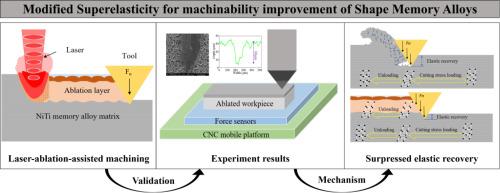改善形状记忆合金可加工性的改良超弹性
IF 9.4
1区 工程技术
Q1 ENGINEERING, MECHANICAL
International Journal of Mechanical Sciences
Pub Date : 2025-09-12
DOI:10.1016/j.ijmecsci.2025.110827
引用次数: 0
摘要
形状记忆合金(SMA)具有优异的超弹性,但其在加工过程中的弹性恢复严重限制了加工效率和尺寸精度。为了克服这一挑战,我们提出了一种激光烧蚀辅助加工方法,并使用Ni-Ti SMA作为代表材料对其进行验证。研究表明,在优化参数下,激光改性可以诱导致密的表面微观结构,降低显微硬度,改变热影响区内的元素组成,从而使法向和切向划痕力降低60%以上。更重要的是,该方法有效地抑制了弹性恢复,最低回收率为25%。分子动力学(MD)模拟进一步表明,抑制马氏体相变有助于降低激光修饰层的弹性回复率。砂带磨削试验进一步证实了该方法对sma加工时的弹性恢复有抑制作用。这些发现为控制SMA的变形机制提供了新的见解,并为其高质量加工提供了可行的途径。本文章由计算机程序翻译,如有差异,请以英文原文为准。

Modified Superelasticity for machinability improvement of shape memory alloys
Shape memory alloy (SMA) exhibit outstanding superelasticity, yet their elastic recovery during machining severely limits efficiency and dimensional accuracy. To overcome this challenge, we propose a laser-ablation-assisted machining approach and validate it using Ni–Ti SMA as a representative material. The study shows that laser modification induces dense surface microstructures, reduces microhardness, and alters elemental composition within the heat-affected zone, thereby lowering both normal and tangential scratching force by over 60% under optimized parameters. More importantly, the method effectively suppresses elastic recovery, achieving a minimum recovery rate of 25%. Molecular dynamics (MD) simulations further reveal that the suppression of martensitic transformation in the laser-modified layer contributes to the reduced elastic recovery. Belt grinding tests further confirm that the proposed technique suppresses the elastic recovery when machining SMAs. These findings provide new insights into controlling deformation mechanisms in SMA and offer a viable route toward their high-quality machining.
求助全文
通过发布文献求助,成功后即可免费获取论文全文。
去求助
来源期刊

International Journal of Mechanical Sciences
工程技术-工程:机械
CiteScore
12.80
自引率
17.80%
发文量
769
审稿时长
19 days
期刊介绍:
The International Journal of Mechanical Sciences (IJMS) serves as a global platform for the publication and dissemination of original research that contributes to a deeper scientific understanding of the fundamental disciplines within mechanical, civil, and material engineering.
The primary focus of IJMS is to showcase innovative and ground-breaking work that utilizes analytical and computational modeling techniques, such as Finite Element Method (FEM), Boundary Element Method (BEM), and mesh-free methods, among others. These modeling methods are applied to diverse fields including rigid-body mechanics (e.g., dynamics, vibration, stability), structural mechanics, metal forming, advanced materials (e.g., metals, composites, cellular, smart) behavior and applications, impact mechanics, strain localization, and other nonlinear effects (e.g., large deflections, plasticity, fracture).
Additionally, IJMS covers the realms of fluid mechanics (both external and internal flows), tribology, thermodynamics, and materials processing. These subjects collectively form the core of the journal's content.
In summary, IJMS provides a prestigious platform for researchers to present their original contributions, shedding light on analytical and computational modeling methods in various areas of mechanical engineering, as well as exploring the behavior and application of advanced materials, fluid mechanics, thermodynamics, and materials processing.
 求助内容:
求助内容: 应助结果提醒方式:
应助结果提醒方式:


